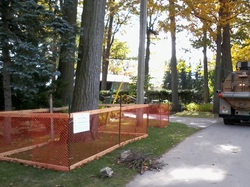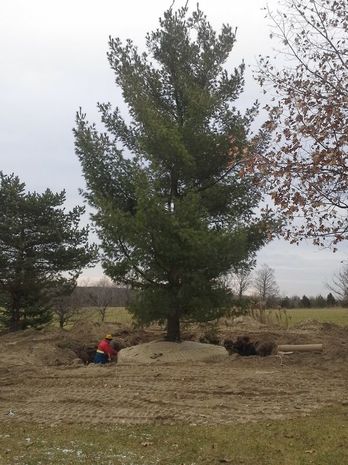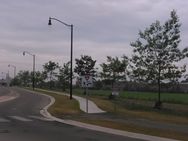"Acting Today for Future Generations"
Urban Watershed Forestry and Arboriculture

Protection of trees during nearby excavating
Urban watershed forestry integrates the fields of urban and community forestry and watershed planning. Urban and community forestry focuses on the management of the urban forest for environmental, community, and economic benefits, while watershed planning promotes sound land use and resource management to improve water resources within a watershed. This integration of urban forestry techniques into urban watershed planning acknowledges the importance of trees,forests and soils in protecting water resources. Arboriculture's focus on individual trees in our landscape becomes a component of Urban Watershed Forestry.
This service is designed to ensure the protection and enhancement of existing treed and green spaces when possible and the establishment of new highly functional landscapes of lasting value.
StormWaterForestry provides CAD friendly planning and reports, site monitoring and inspections as well as project management to assist our clients in the development and implementation of sustainable sites. This service is applicable for small retrofit projects right through to large commercial and residential developments. The greatest benefits will be recognized when applied early in the planning stages.
This service is designed to ensure the protection and enhancement of existing treed and green spaces when possible and the establishment of new highly functional landscapes of lasting value.
StormWaterForestry provides CAD friendly planning and reports, site monitoring and inspections as well as project management to assist our clients in the development and implementation of sustainable sites. This service is applicable for small retrofit projects right through to large commercial and residential developments. The greatest benefits will be recognized when applied early in the planning stages.
Urban Soil Management Planning (SMP)

sidewalk replacement & root damage resulting from poor soil
Urban soils historically have been the most under-managed component in the land development process. Urban soils have a profound impact on stormwater management and urban tree cover. When designed and installed to perform correctly, urban soils become the foundation for sustainable developments.
Urban Soil Management is the planning and management of soil prior to, during and after land development to maximize the soils ability to support healthy landscapes, urban forests and effective stormwater management. An increasing number of municipalities are requiring a soil management plan prior to permit approval.
Urban Soil Management is the planning and management of soil prior to, during and after land development to maximize the soils ability to support healthy landscapes, urban forests and effective stormwater management. An increasing number of municipalities are requiring a soil management plan prior to permit approval.
The Process of SMP

Soil management plans and their implementation can be performed on any scale from a single lot or yard renovation to an entire development. The plan consists of the following:
A review of the site and existing soils in the planning stage to determine which soil/vegetation areas can be left undisturbed and protected or enhanced and which areas will be impacted by construction activity
Determine whether soil to be stripped will remain and where, or be removed from the site.
Determine if soil stored on site will need amending (based on testing) to meet specifications and/or set the specifications for soil which will be imported.
Determine subsoil treatment required to meet specifications
Develop a plan to monitor and verify all specifications are met from initial construction activity through to project completion with a final verification of the finished site. This plan is integrated as part of the stormwater management plan for the site
Commonly available Low Ground Pressure (LGP) and subsoiling equipment may be required to meet the specifications.
A review of the site and existing soils in the planning stage to determine which soil/vegetation areas can be left undisturbed and protected or enhanced and which areas will be impacted by construction activity
Determine whether soil to be stripped will remain and where, or be removed from the site.
Determine if soil stored on site will need amending (based on testing) to meet specifications and/or set the specifications for soil which will be imported.
Determine subsoil treatment required to meet specifications
Develop a plan to monitor and verify all specifications are met from initial construction activity through to project completion with a final verification of the finished site. This plan is integrated as part of the stormwater management plan for the site
Commonly available Low Ground Pressure (LGP) and subsoiling equipment may be required to meet the specifications.
Erosion and Sediment Control Planning and Monitoring (ESC)

City of Vaughan, TRCA 2006
Erosion and Sediment Control planning and monitoring is now a basic requirement for most land development. Failure to implement an ESC plan or stay in compliance with standards has both environmental and economic costs. StormWaterForestry can assist in the development and implementation of a plan and monitoring of the site to ensure compliance.
Low Impact Development Stormwater Management (LID SWM)

Integration of green infrastructure into traditional stormwater designs and practices produces a more efficient and cost effective SWM system. It requires a multi-disciplinary approach to ensure the maximum benefits are achieved. StormWaterForestry can assist municipalities, developers and other design professionals to integrate LID into their designs. LID emphasizes conservation and use of on-site natural features to protect water quality. This approach implements engineered small-scale hydrologic controls to replicate the pre-development hydrologic regime of watersheds through infiltrating, filtering, storing, evaporating, and detaining runoff close to its source.






